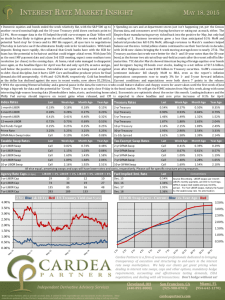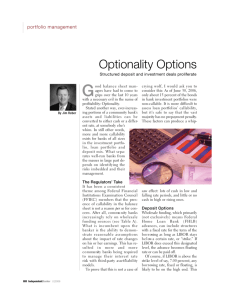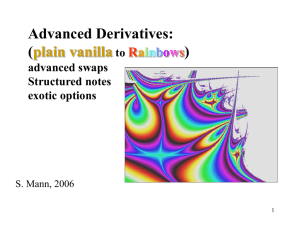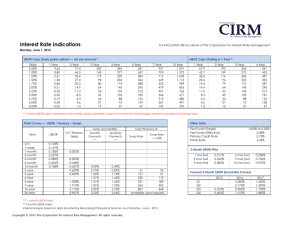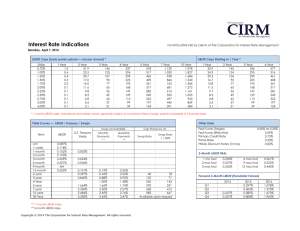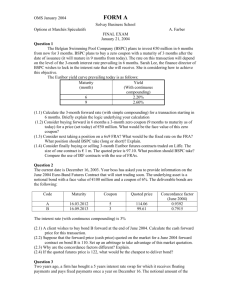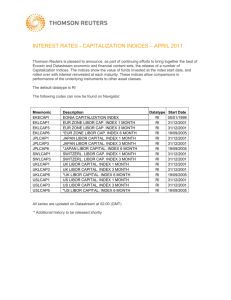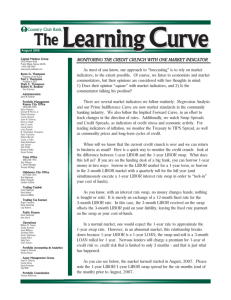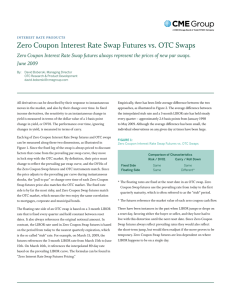BUILDING A YIELD CURVE GENERATOR 1. Libor and Swap Rates
advertisement
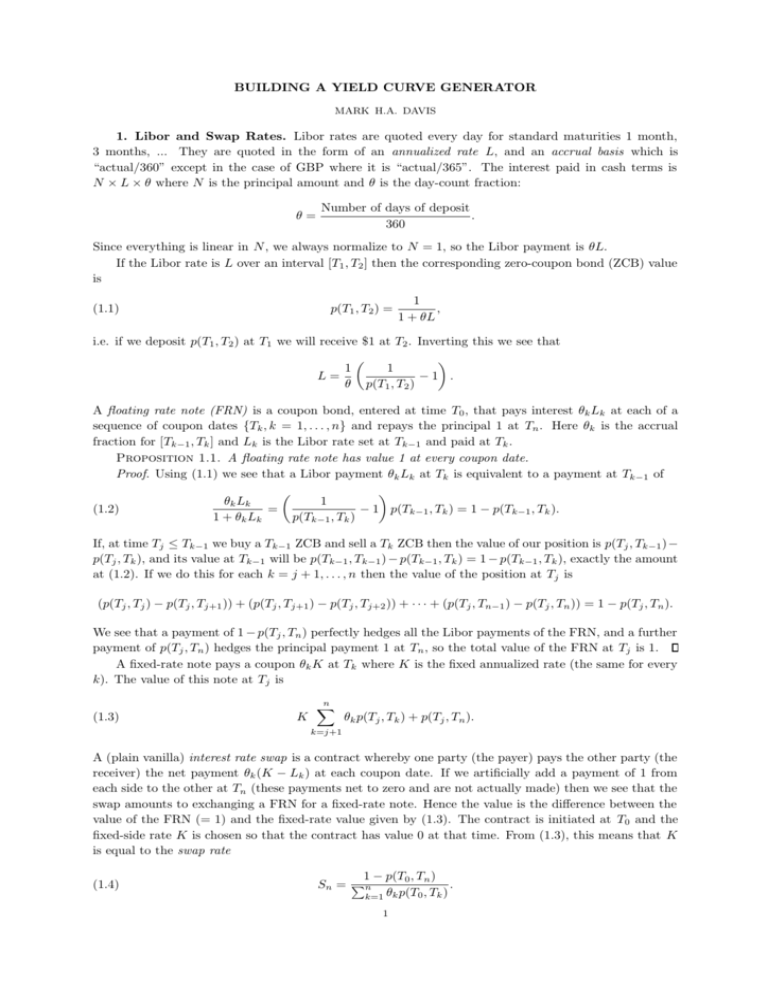
BUILDING A YIELD CURVE GENERATOR
MARK H.A. DAVIS
1. Libor and Swap Rates. Libor rates are quoted every day for standard maturities 1 month,
3 months, ... They are quoted in the form of an annualized rate L, and an accrual basis which is
“actual/360” except in the case of GBP where it is “actual/365”. The interest paid in cash terms is
N × L × θ where N is the principal amount and θ is the day-count fraction:
θ=
Number of days of deposit
.
360
Since everything is linear in N , we always normalize to N = 1, so the Libor payment is θL.
If the Libor rate is L over an interval [T1 , T2 ] then the corresponding zero-coupon bond (ZCB) value
is
p(T1 , T2 ) =
(1.1)
1
,
1 + θL
i.e. if we deposit p(T1 , T2 ) at T1 we will receive $1 at T2 . Inverting this we see that
1
L=
θ
1
−1 .
p(T1 , T2 )
A floating rate note (FRN) is a coupon bond, entered at time T0 , that pays interest θk Lk at each of a
sequence of coupon dates {Tk , k = 1, . . . , n} and repays the principal 1 at Tn . Here θk is the accrual
fraction for [Tk−1 , Tk ] and Lk is the Libor rate set at Tk−1 and paid at Tk .
Proposition 1.1. A floating rate note has value 1 at every coupon date.
Proof. Using (1.1) we see that a Libor payment θk Lk at Tk is equivalent to a payment at Tk−1 of
(1.2)
θk L k
=
1 + θk Lk
1
p(Tk−1 , Tk )
− 1 p(Tk−1 , Tk ) = 1 − p(Tk−1 , Tk ).
If, at time Tj ≤ Tk−1 we buy a Tk−1 ZCB and sell a Tk ZCB then the value of our position is p(Tj , Tk−1 )−
p(Tj , Tk ), and its value at Tk−1 will be p(Tk−1 , Tk−1 ) − p(Tk−1 , Tk ) = 1 − p(Tk−1 , Tk ), exactly the amount
at (1.2). If we do this for each k = j + 1, . . . , n then the value of the position at Tj is
(p(Tj , Tj ) − p(Tj , Tj+1 )) + (p(Tj , Tj+1 ) − p(Tj , Tj+2 )) + ∙ ∙ ∙ + (p(Tj , Tn−1 ) − p(Tj , Tn )) = 1 − p(Tj , Tn ).
We see that a payment of 1 − p(Tj , Tn ) perfectly hedges all the Libor payments of the FRN, and a further
payment of p(Tj , Tn ) hedges the principal payment 1 at Tn , so the total value of the FRN at Tj is 1.
A fixed-rate note pays a coupon θk K at Tk where K is the fixed annualized rate (the same for every
k). The value of this note at Tj is
(1.3)
K
n
X
θk p(Tj , Tk ) + p(Tj , Tn ).
k=j+1
A (plain vanilla) interest rate swap is a contract whereby one party (the payer) pays the other party (the
receiver) the net payment θk (K − Lk ) at each coupon date. If we artificially add a payment of 1 from
each side to the other at Tn (these payments net to zero and are not actually made) then we see that the
swap amounts to exchanging a FRN for a fixed-rate note. Hence the value is the difference between the
value of the FRN (= 1) and the fixed-rate value given by (1.3). The contract is initiated at T0 and the
fixed-side rate K is chosen so that the contract has value 0 at that time. From (1.3), this means that K
is equal to the swap rate
(1.4)
1 − p(T0 , Tn )
.
S n = Pn
k=1 θk p(T0 , Tk )
1
2. Backing out ZCB values from market data. Zero coupon bonds are not directly traded
assets. Their value must be inferred from the prices of contracts actually traded in the markets. These
are
• Libor rates
• Interest rate futures
• Swap rates
As mentioned above, Libor rates are directly quoted for various maturities up to 1 year and maybe more.
There is also a huge market in swaps of maturities up to 10 years, and significant trading in longer-dated
swaps out to 30 years or more. In this note we will not deal with interest rate futures: unlike the other
two classes, their pricing is not model-independent and presents a more delicate problem.
2.1. Use of swap data to infer ZCB values. Let us first consider the simple, but unrealistic,
case where swap rates S1 , . . . , Sn are quoted in the market for all maturity times T1 , . . . , Tn where we
assume that the coupon dates are the same for all swaps. From (1.4) with n = 1
1 − p(T0 , T1 )
1
1
=
− 1 = L1 .
S1 =
θ1 p(T0 , T1 )
θ1 p(T0 , T1 )
That is, the 1-period swap rate is equal to the Libor rate, and hence from (1.1)
p(T0 , T1 ) =
1
.
1 + θ 1 S1
Now suppose p(T0 , Ti ) have been determined for i = 1, . . . , k, and let Ak =
(1.4)
Sk+1 =
Pk
i=1 θ1 p(T0 , Ti ).
Then from
1 − p(T0 , Tk+1 )
,
Ak + θk+1 p(T0 , Tk+1 )
so that
p(T0 , Tk+1 ) =
1 − Sk+1 Ak
.
1 + θk+1 Sk+1
We can thus recursively determine all the p(T0 , Tk ) values.
2.1.1. Interpolation. To determine values p(T0 , t) for times t that are not coupon dates, the normal
procedure is to use linear interpolation of rates. Specifically, suppose t = (1 − λ)Tk + λTk+1 for some
λ ∈ (0, 1). We write p(T0 , Tk ) = e−rk Tk and p(T0 , Tk+1 ) = e−rk+1 Tk+1 (defining rk , rk+1 ), set r =
(1 − λ)rk + λrk+1 and define
p(T0 , t) = e−rt .
2.1.2. Missing data. Invariably, some of the Sk values will not be available. Suppose we have
determined p(T0 , Tk ) and the next swap rate available is Sk+j . For i = 1, . . . , j − 1 let P̂i (p) be the interpolation of P (T0 , Tk ) and the as yet unknown p = P (T0 , Tk+j ) as given above. Then using interpolated
values where necessary we have
(2.1)
Sk+j =
1−p
Ak + θk+1 P̂k+1 (p) + ∙ ∙ ∙ + θk+j−1 P̂k+j−1 (p) + θk+j p
We now have to solve equation (2.1) for p (given Sk+j and Ak ). The solution is p = P (T0 , Tk+j ) and then
all intermediate discount factors are defined by interpolation as in (2.1). Note that the right-hand side
of (2.1) (call it f (p)) is monotone decreasing in p and f (1) = 0. Assuming f (0) > Sk+j (this is highly
likely—why?) we can solve the equation f (p) = Sk+j by binary search:
1. Set l = 0, r = 1
2. Set m = (l + r)/2
3. If f (m) < Sk+1 then set r = m, else l = m
4. Repeat 2 and 3 until |f (m) − Sk+1 | < 5. Return P (T0 , Tk+j )) = m.
le up to one yea
2
3. Yield curve construction. The data is typically similar to that shown in Table 3.1. (Interest
rate futures are not included.) Libor rates are available up to 1 year maturity and these directly define the
corresponding discount factors via (1.1). Values P (T0 , t) for other times t less than 1 year are determined
by interpolation. For t > 1 year, apply the procedure described in section 2.1. Note that we only have
swap quotes for integer numbers of years, but there is a coupon every 6 months, so in the notation of
Section 2.1.2 we will have j = 2 at each stage.
Libor rates
Swap rates
Maturity in years
Maturity
Overnight
1 month
3 months
6 months
1 year
2
3
4
5
6
7
8
9
10
Rate (%, annualized)
0.29
0.38
0.60
0.91
1.21
1.51
1.90
2.23
2.51
2.76
2.96
3.13
3.27
3.39
Table 3.1
EUR yield curve, 17.02.10. Rates up to and including 1 year are Libor rates, rates beyond 1 year are swap rates,
semi-annual coupon, 30/360 accrual basis.
3


